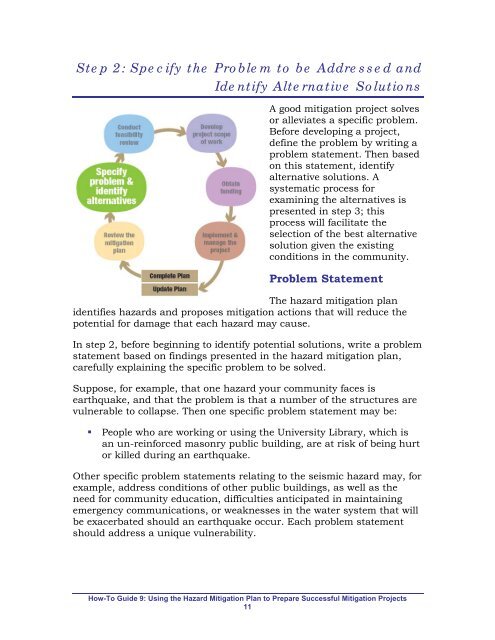Using the Hazard Mitigation Plan to Prepare Successful Mitigation ...
Using the Hazard Mitigation Plan to Prepare Successful Mitigation ...
Using the Hazard Mitigation Plan to Prepare Successful Mitigation ...
You also want an ePaper? Increase the reach of your titles
YUMPU automatically turns print PDFs into web optimized ePapers that Google loves.
Step 2: Specify <strong>the</strong> Problem <strong>to</strong> be Addressed and<br />
Identify Alternative Solutions<br />
A good mitigation project solves<br />
or alleviates a specific problem.<br />
Before developing a project,<br />
define <strong>the</strong> problem by writing a<br />
problem statement. Then based<br />
on this statement, identify<br />
alternative solutions. A<br />
systematic process for<br />
examining <strong>the</strong> alternatives is<br />
presented in step 3; this<br />
process will facilitate <strong>the</strong><br />
selection of <strong>the</strong> best alternative<br />
solution given <strong>the</strong> existing<br />
conditions in <strong>the</strong> community.<br />
Problem Statement<br />
The hazard mitigation plan<br />
identifies hazards and proposes mitigation actions that will reduce <strong>the</strong><br />
potential for damage that each hazard may cause.<br />
In step 2, before beginning <strong>to</strong> identify potential solutions, write a problem<br />
statement based on findings presented in <strong>the</strong> hazard mitigation plan,<br />
carefully explaining <strong>the</strong> specific problem <strong>to</strong> be solved.<br />
Suppose, for example, that one hazard your community faces is<br />
earthquake, and that <strong>the</strong> problem is that a number of <strong>the</strong> structures are<br />
vulnerable <strong>to</strong> collapse. Then one specific problem statement may be:<br />
• People who are working or using <strong>the</strong> University Library, which is<br />
an un-reinforced masonry public building, are at risk of being hurt<br />
or killed during an earthquake.<br />
O<strong>the</strong>r specific problem statements relating <strong>to</strong> <strong>the</strong> seismic hazard may, for<br />
example, address conditions of o<strong>the</strong>r public buildings, as well as <strong>the</strong><br />
need for community education, difficulties anticipated in maintaining<br />
emergency communications, or weaknesses in <strong>the</strong> water system that will<br />
be exacerbated should an earthquake occur. Each problem statement<br />
should address a unique vulnerability.<br />
How-To Guide 9: <strong>Using</strong> <strong>the</strong> <strong>Hazard</strong> <strong>Mitigation</strong> <strong>Plan</strong> <strong>to</strong> <strong>Prepare</strong> <strong>Successful</strong> <strong>Mitigation</strong> Projects<br />
11

















